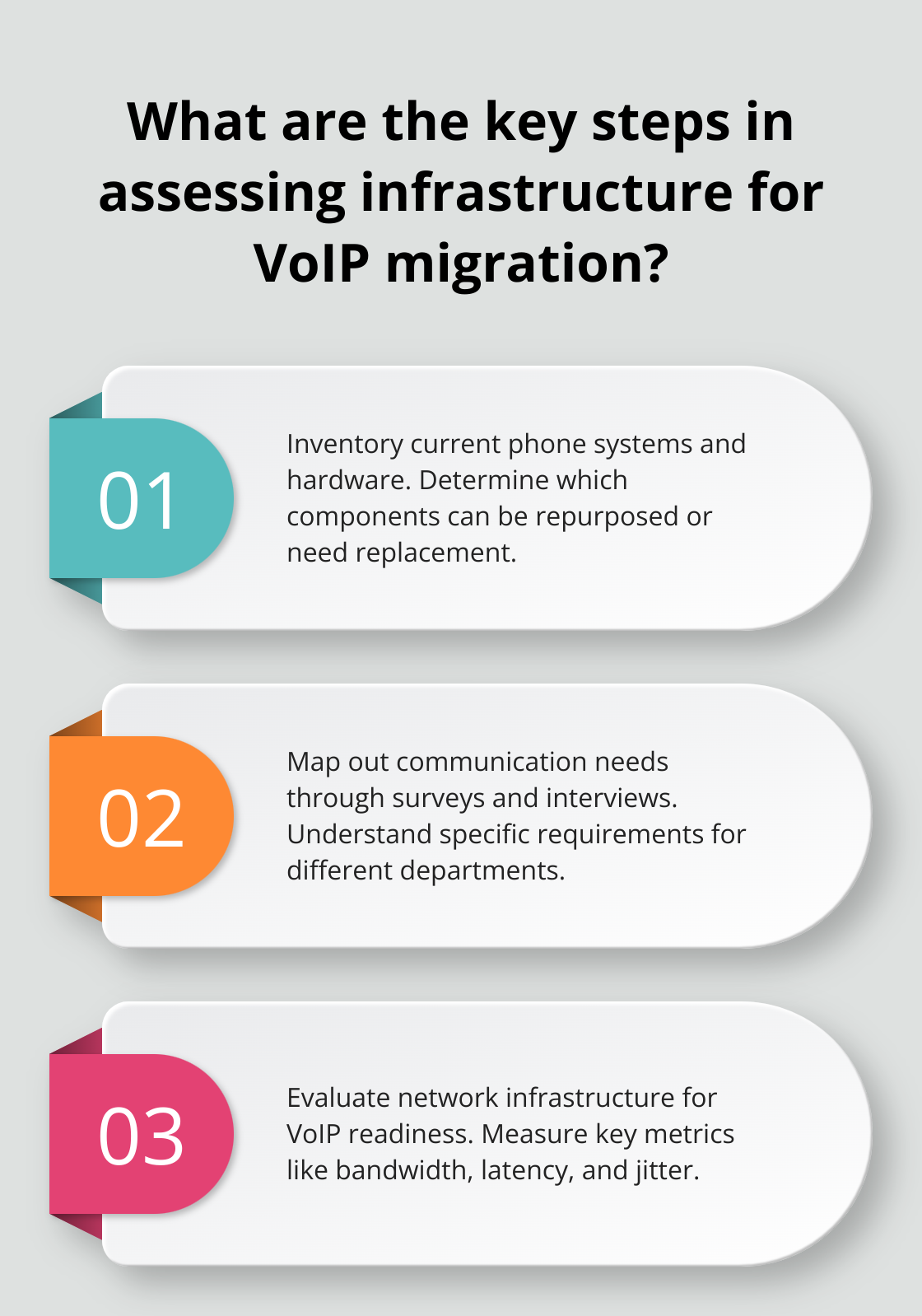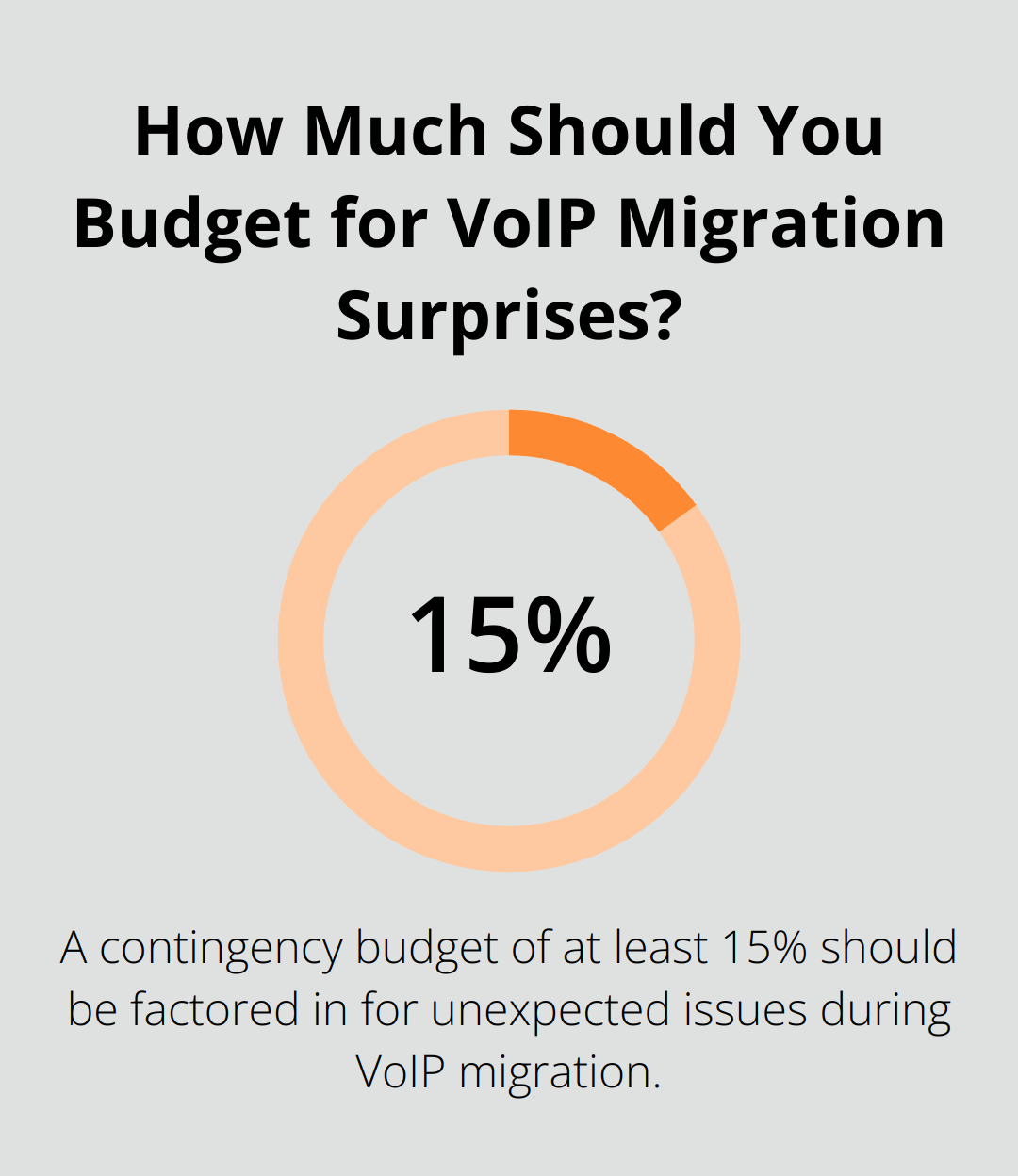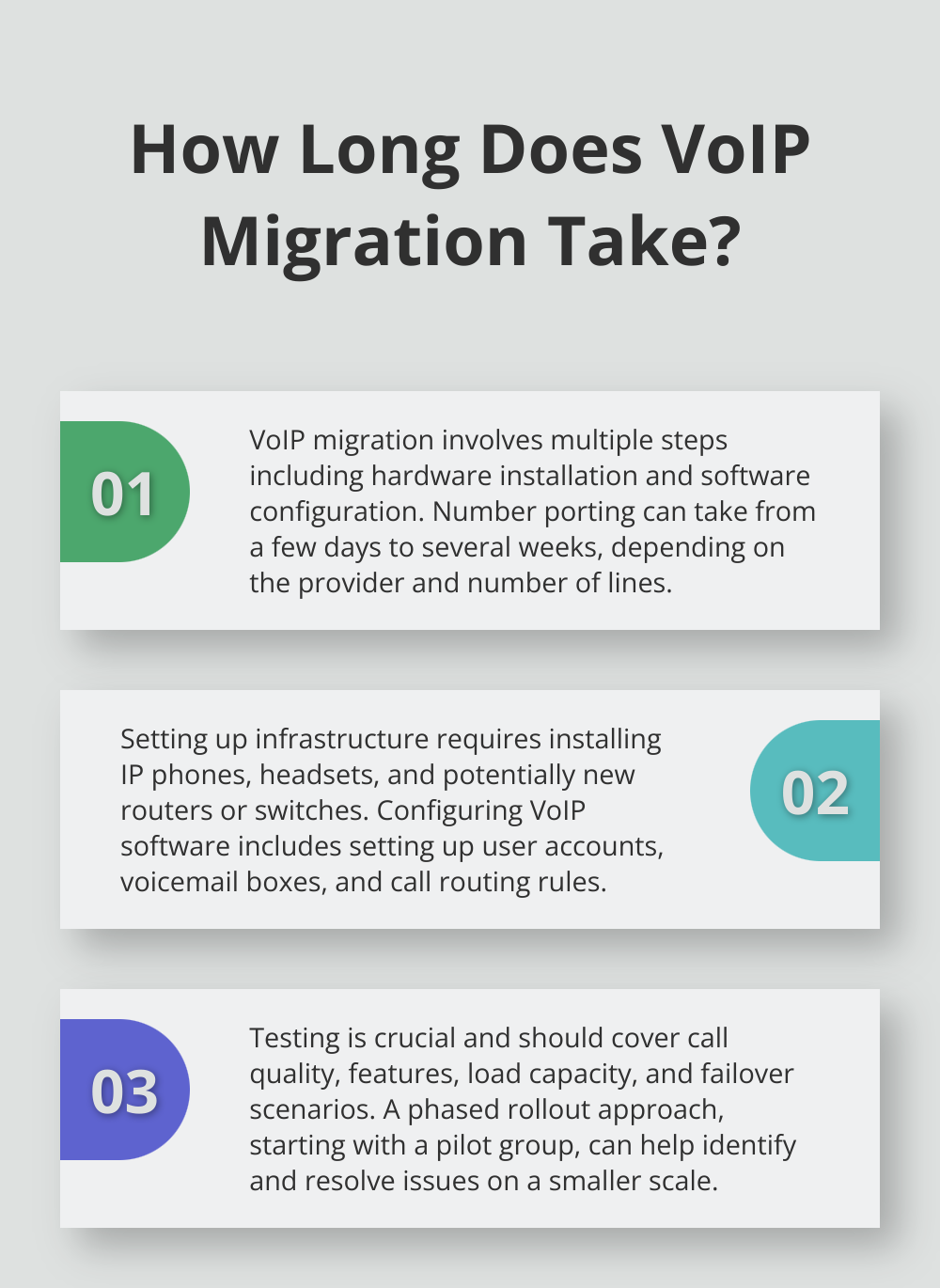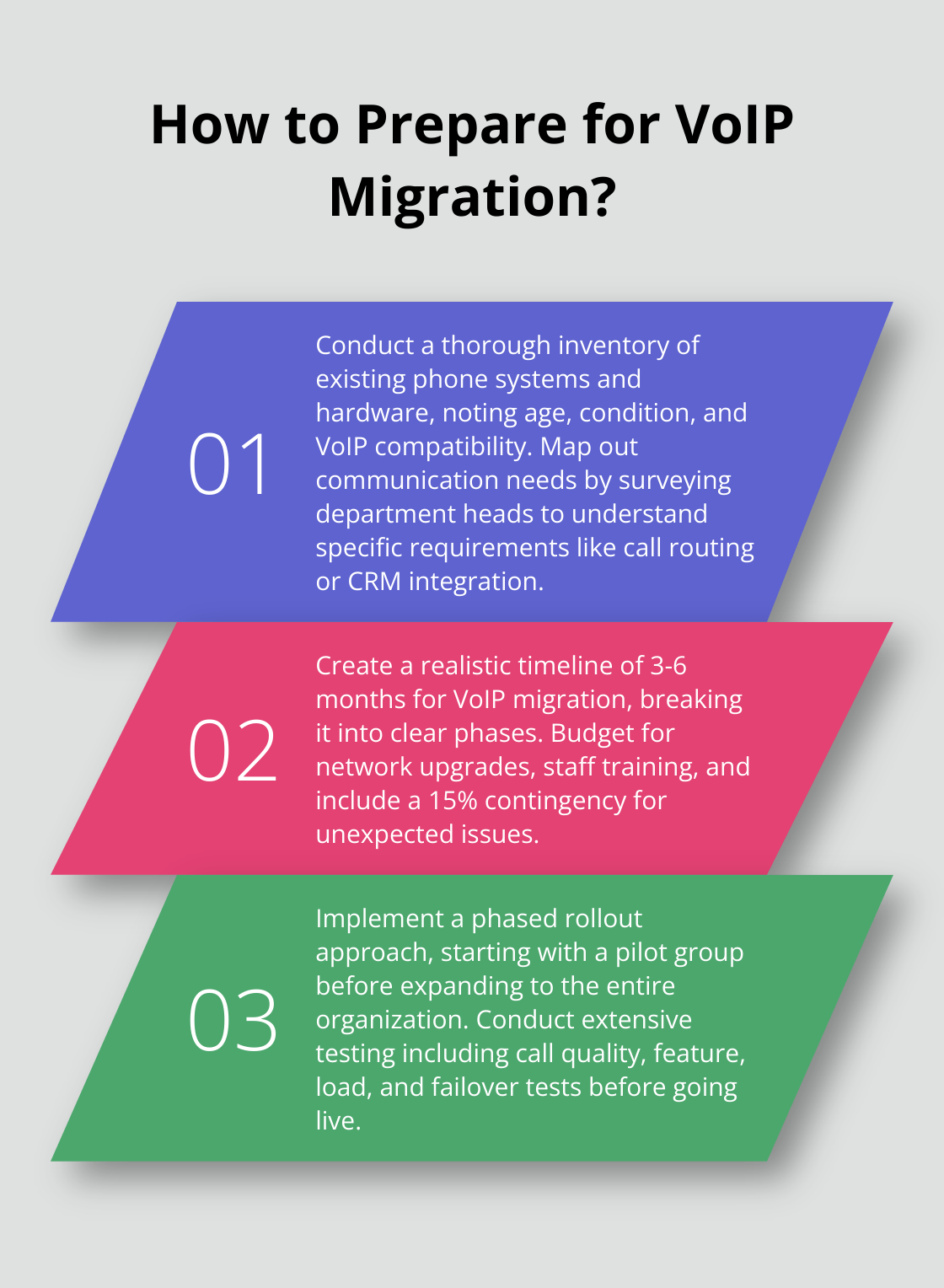VoIP migration can be a game-changer for enterprises, but it’s not without its challenges.
At UCaaS Review, we’ve seen businesses struggle with the transition, often due to poor planning and execution.
This guide will walk you through proven strategies to ensure a smooth VoIP migration, helping your enterprise reap the benefits of modern communication technology without the headaches.
How to Assess Your Current Infrastructure for VoIP Migration
Inventory Your Current Phone Systems
The first step in VoIP migration involves a thorough inventory of your existing phone systems and hardware. This includes PBX systems, desk phones, conference room equipment, and other communication devices. Take note of the age, condition, and VoIP compatibility of each item. This inventory will help you determine which components you can repurpose and which need replacement, providing a clear picture of your migration scope and potential costs.
Map Out Your Communication Needs
After inventorying your hardware, outline your business communication requirements. This task extends beyond listing features; it requires a deep understanding of how your teams communicate and collaborate. Conduct surveys or interviews with department heads to gather insights on their specific needs. For example, your sales team might require advanced call routing and CRM integration, while your customer service department may need robust call recording capabilities.
Evaluate Your Network Infrastructure
Your network’s readiness for VoIP is a critical aspect of this assessment. VoIP calls demand a stable and robust network to maintain call quality. Start with a network assessment to measure key metrics such as bandwidth, latency, and jitter. Tools like Wireshark or SolarWinds can assist in gathering this data.

If your current network falls short of these benchmarks, plan for necessary upgrades. This might include increasing bandwidth, implementing Quality of Service (QoS) protocols, or upgrading network hardware. Keep in mind that a network that’s barely adequate for data may struggle with the added demands of voice traffic.
Assess Security Measures
VoIP systems introduce new security considerations that your current infrastructure might not address. Evaluate your existing security measures and identify potential vulnerabilities. This assessment should include firewall configurations, encryption protocols, and access controls. Consider implementing additional security measures such as Session Border Controllers (SBCs) to protect against VoIP-specific threats.
Determine Scalability Requirements
Consider your business growth projections when assessing your infrastructure. Your new VoIP system should accommodate future expansion without requiring a complete overhaul. Evaluate your current user count and estimate potential growth over the next 3-5 years. This foresight will help you choose a VoIP solution that can scale with your business, avoiding costly upgrades in the near future.
A thorough assessment of your current infrastructure lays the groundwork for a successful VoIP migration. With this information in hand, you’re now ready to move on to the next crucial step: planning your VoIP migration strategy.
How to Plan Your VoIP Migration
Selecting the Right VoIP Provider
The selection of an appropriate VoIP provider forms the foundation of a successful migration. When you evaluate providers, consider their uptime guarantees, customer support availability, and scalability options. Look beyond features and examine the provider’s network infrastructure and data center locations. A provider with geographically dispersed data centers can offer superior call quality and redundancy.

Create a shortlist of at least three providers and request detailed proposals. These should include pricing, implementation timelines, support plans, and service level agreements (SLAs). The cheapest option isn’t always the best – factor in the total cost of ownership, including potential downtime and productivity losses.
Crafting a Realistic Timeline and Budget
VoIP migrations require time. A realistic timeline for a mid-sized enterprise typically spans 3-6 months, from initial planning to full implementation. Break your timeline into clear phases: assessment, provider selection, infrastructure upgrades, pilot testing, full rollout, and post-implementation review.
Budgeting for VoIP migration extends beyond the cost of new phones and monthly service fees. Include line items for network upgrades, staff training, and potential productivity dips during the transition period. Also, factor in a contingency budget of at least 15% for unexpected issues.
Employee Training: The Key to Adoption
The success of your VoIP migration depends on user adoption. A comprehensive training plan is essential. Start by identifying VoIP champions within each department who can act as go-to resources for their colleagues.
Schedule training sessions well in advance of the migration. These should cover basic functionality and advanced features that can boost productivity. For example, show sales teams how to integrate the VoIP system with your CRM for more efficient call logging.
Consider different learning styles when you develop your training materials. Offer a mix of hands-on workshops, video tutorials, and written guides.
Don’t overlook the training of your IT staff on the new system’s backend. They’ll need to understand how to troubleshoot common issues and manage the VoIP infrastructure effectively.
Ensuring Network Readiness
Before you implement your VoIP system, ensure your network can handle the increased traffic. Conduct a thorough network assessment (including bandwidth, latency, and jitter tests) to identify potential bottlenecks. Upgrade your infrastructure as needed, which may include increasing bandwidth or implementing Quality of Service (QoS) protocols.
Planning for Security
VoIP systems introduce new security considerations. Develop a comprehensive security plan that includes firewall configurations, encryption protocols, and access controls. Consider implementing Session Border Controllers (SBCs) to protect against VoIP-specific threats.
With a solid plan in place, you’re ready to move on to the next phase: executing your VoIP migration. This step will involve setting up new hardware and software, porting phone numbers, and rigorously testing your new system.
How to Execute Your VoIP Migration
Setting Up Your VoIP Infrastructure
Start your VoIP migration by installing new hardware. This includes IP phones, headsets, and potentially new routers or switches. Many modern VoIP systems use Power over Ethernet (PoE), so check if your network switches support this feature. If not, install PoE injectors (also called PoE adapters) to power your PoE-enabled VoIP phones and IP cameras.

Next, configure your VoIP software. Set up user accounts, voicemail boxes, and call routing rules. Pay attention to your firewall settings. VoIP traffic uses specific ports (typically UDP 5060 for SIP), which need to be open for optimal performance. Work with your IT team to balance functionality and protection.
Porting Numbers and Configuring Call Routing
Number porting often takes the most time in a VoIP migration. Start this process early, as it can take from a few days to several weeks, depending on your current provider and the number of lines you’re porting.
While waiting for number porting to complete, set up your call routing. Create hunt groups, set up auto-attendants, and configure call queues. Use this opportunity to optimize your call flow. You might set up skills-based routing to improve agent performance, personalize customer experience, and reduce agent training demands.
Testing and Troubleshooting
Before going live, conduct extensive testing of your new VoIP system. This should include:
- Call quality tests: Make test calls to check for issues like echo, latency, or jitter.
- Feature testing: Verify that all features (call forwarding, voicemail-to-email, etc.) work as expected.
- Load testing: Simulate peak call volumes to ensure your network can handle the traffic.
- Failover testing: Check that calls route properly if a primary line goes down.
During testing, you’ll likely encounter issues. Common problems include echo (often caused by improper gain settings), one-way audio (usually a firewall issue), or poor call quality (often due to insufficient bandwidth or QoS settings).
Document all issues and their resolutions. This will help with troubleshooting post-migration and for training your IT staff.
Phased Rollout Approach
Try a phased rollout for smoother migrations. Consider starting with a pilot group (perhaps a single department) before expanding to the entire organization. This approach allows you to identify and resolve issues on a smaller scale, minimizing disruption to your business operations.
Ongoing Optimization and Support
After the initial migration, focus on ongoing optimization and support. Monitor call quality regularly and adjust network settings as needed. Provide continuous training for employees to ensure they’re using the new system effectively. Keep your VoIP solutions software and firmware up-to-date to benefit from the latest features and security patches.
Final Thoughts
VoIP migration transforms enterprise communication, offering improved call quality, flexibility, and cost savings. This technology enables advanced features like video conferencing and seamless integration with business tools, fostering a more collaborative work environment. VoIP systems provide the agility needed to respond quickly to changing market conditions and customer demands, making them essential for businesses of all sizes.

A successful VoIP migration requires careful planning, expert guidance, and the right tools. UCaaS Review uses AI technology to match businesses with the best Unified Communications as a Service providers in just three minutes. Our platform offers unbiased evaluations based on verified user reviews, ensuring you make an informed decision that aligns with your specific communication needs.
Don’t let the fear of change hold your business back. Embrace the power of VoIP technology and take your enterprise communication to new heights. With the right strategy and support, your VoIP migration can propel your business forward in the digital age.



